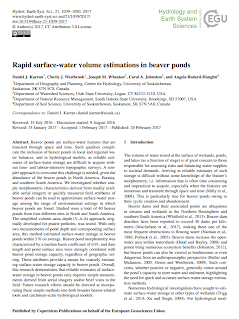0 Comments
Nahorniak et al. Paper on how to automate Delft Hydraulic modelling with AWS for 1000's of visits9/3/2018
Originally posted May 18, 2017, 3:41 PM by Joe Wheaton
 In this ambitious State of the Science article we lay out a pragmatic method for realizing the vision Fausch et al. (2002) spelt out over 15 years ago. Many years of geomorphology and ecohydraulic research at the reach-scale has led to better mechanistic understanding of the drivers of fish habitat. However, little of this research has been directly tied across entire riverscapes to assess the significance of fish habitat on actual fish populations. We lay out a framework, using the wealth of data from Columbia Habitat Monitoring Program (CHaMP) to connect the dots and upscale this understanding across entire drainage networks. In McHugh et al. (2017) we present a case study of how this is actually done. In Wheaton et al. (2017), we illustrate and describe conceptually how to leverage various advances that have been made in isolation in the fields of remote sensing, ecohydraulics, network modelling and life cycle modelling to take things a step further and answer some fundamental questions about fish populations of major societal and management relevance.
Originally posted May 17, 2017, 5:35 PM by Joe Wheat
 Pete McHugh and Carl Saunders led this effort in the Middle Fork John Day to demonstrate how site scale NREI models (e.g. Wall et al, 2016) to inform network scale models to produce fish population capacity estimates that can drive life cycle models. They then use this approach to produce realistic restoration scenarios to see what sort of capacity increases might be produced by various restoration alternatives and what (if any) population level impact this may have. This framework and vision was laid out conceptually in Wheaton et al. (2017), and this case study application and the online supplement provide many of the methodological details for how to pull it together. The McHugh et al. (2017) paper was just published in Ecological Modelling.
Originally posted May 17, 2017, 5:17 PM by Joe Wheaton
 Nick Weber led an effort to publish findings from the Bridge Creek beaver restoration project on impacts of beaver dam analogues (BDAs) on summer stream temperatures. The Weber et al. (2017) paper was just published in PLOSone.
Originally posted May 17, 2017, 5:06 PM by Joe Wheaton
 Gary O'Brien led this effort with collaborators Kirstie Fryirs and Gary Brierley. In this Journal of Maps article, we show how a geomorphic assessment using River Styles can be used to inform watershed restoration planning and prioritization:
Originally posted Apr 23, 2017, 6:42 PM by Joe Wheaton
 Daniel Karran (a PhD student of Cherie Westbrook at University of Saskatchewan) led an effort to test how well simple methods for estimating surface water storage volume from just surface area and dam height works for beaver ponds. The methods have been used widely in estimating storage in wetlands and prairie pot-holes, and provide a nice morphometric approach to estimating dams from area (easy to measure off aerial imagery) and dam height, which can be quickly measured in the field. This allows foregoing the effort of full topographic surveys to estimate pond volumes. Given the growing interest in beaver as a restoration and climate adaptation tool, methods for quickly estimating their impact on hydrology (in this case through increasing surface water storage) are very topical.
Originally posted Feb 20, 2017, 1:31 PM by Joe Wheaton
|
AuthorWrite something about yourself. No need to be fancy, just an overview. Archives
September 2018
Categories |















 RSS Feed
RSS Feed



